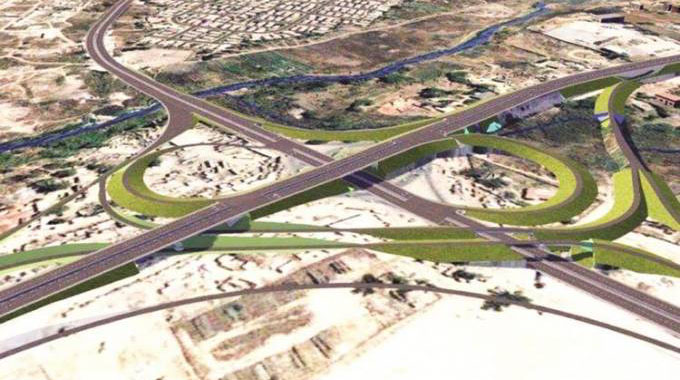Mbudzi interchange flyover moves gear up
Construction of Mbudzi flyover moved a gear up with contractors now working on the first part of the actual structure, extending the Glen Norah bridge which will house a slip lane heading into the Harare-Masvingo Highway.
The works follow the completion of geotechnical engineering tests, which involves taking soil and rock samples to ascertain the strength of materials to be used during the foundation stage.
The complex flyover is a major civil engineering work and it is essential that the huge reinforced concrete structure is anchored to the bedrock and can cope easily with the continual vibration of thousands of heavy vehicles a day. As of Tuesday, motorists were taking turns to use Glen Norah Road, which has only single lane traffic at the moment to give access to the tipper trucks that were offloading gravel being used to divert water and create space for the construction of the bridge.
Caterpillar equipment belonging to the contractors, Tefoma Joint Venture, was also observed clearing land for the extension of the new bridge.
Pirate taxis commonly known as mushikashika were making life difficult for the contractors as they were operating in their vicinity. Harare provincial roads engineer Arthurton Zindoga said: “The contractor is doing preparatory works on bridges and detour roads.”
Tefoma Joint Venture workers said while preparatory works are being carried out to create detour roads, the extension of the bridge marks the start of the actual structural works.
“We are extending the existing bridge here which will have a slip lane from Glen Norah Road that connects directly to Harare-Masvingo Highway without passing through the flyover.
“On the other side we will also have another bridge with a slip lane from Simon Mazorodze Road that connects to Chitungwiza road directly without passing through the flyover,” said one of the workers.
“These slip roads are not just part of the final structure but will help with traffic diversions during the year it will take to build the flyover.
Motorists expressed gratitude over the projects.
“We are glad that the project has finally kicked off. Our hope is that it gets all the necessary support. It has been a nightmare using the traffic circle,” said Mr Tinotenda Mawire.
Mrs Angeline Guyo said law -enforcement agents should swiftly move in to deal with errant mushikashikas that are operating at the bridge that is being constructed.
Mbudzi roundabout is at the intersection of Simon Mazorodze, Chitungwiza and High Glen Roads that feed traffic from western Chitungwiza and many old and new suburbs into Harare city centre as well as the heavy national and regional traffic on the HarareMasvingo highway.
In recent years, the roundabout has seen traffic log-jams especially during morning and evening peak hours that see much of this traffic having to go two thirds of the way around the roundabout, basically blocking those on other roads from even accessing the roundabout.
While roundabouts are considered more efficient than traffic lights at such intersections, they even fail and the next stage is the full interchange with bridges and underpasses that allow all traffic to proceed without halting. Slip lanes can handle left-hand turns, but the interchange has to allow right-hand turning traffic to proceed over or under oncoming traffic, as well as allowing all direct cross traffic to move over or under the traffic coming from the right or left.
The construction of the flyover at Mbudzi has been given as the only solution to the roundabout congestion for some years, but has now been moved from a potential municipal works project to a Government project, simply because Harare City Council does not have the capacity.
Much of the work is being largely funded through the financing arrangements for the upgrade of the final phase of the Beitbridge-Masvingo-Harare highway as the roundabout is easily the largest bottleneck on this highway and the gains from the highway upgrade will be minimal if traffic is then blocked.
The roundabout has Chitungwiza Road that not only links that town to the industrial areas, but is also the main feeder road for the swathe of new suburbs across Harare South that have been developed recently.
High Glen Road is the main link for the vast south-western suburbs of Harare, home to at least a quarter of the capital’s population, as well as serving the western parts of the main industrial area.
The combination of all these needs means that not only is traffic heavy, but there are high ratios of heavy trucks and buses in the traffic.
Government is currently in an overdrive rehabilitating roads and infrastructure throughout the country as part of the National Development Strategy 1 (NDS1) and in line with Vision 2030, that is creating a middle income society.-The Herald










